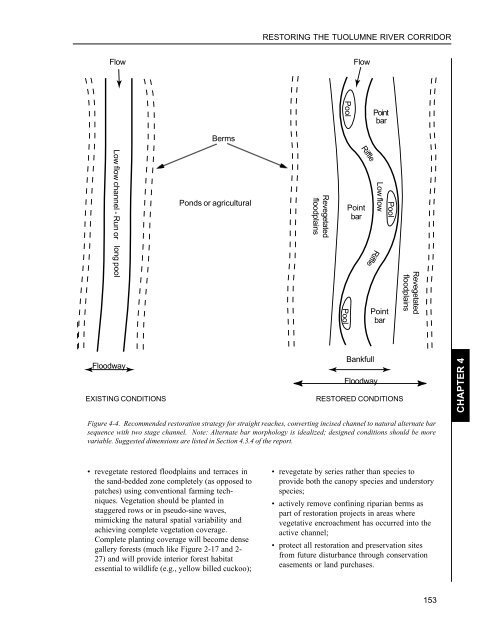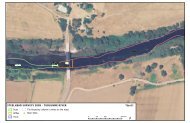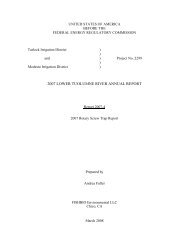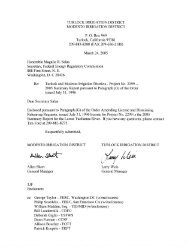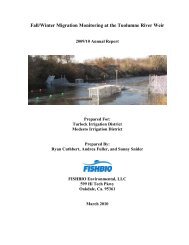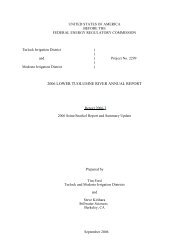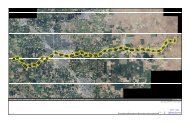- Page 1 and 2:
Habitat Restoration Plan for theLow
- Page 4 and 5:
TUOLUMNE RIVER TECHNICAL ADVISORY C
- Page 6 and 7:
TUOLUMNE RIVER TECHNICAL ADVISORY C
- Page 8 and 9:
TUOLUMNE RIVER TECHNICAL ADVISORY C
- Page 10 and 11:
TUOLUMNE RIVER TECHNICAL ADVISORY C
- Page 12 and 13:
TUOLUMNE RIVER TECHNICAL ADVISORY C
- Page 14 and 15:
TUOLUMNE RIVER TECHNICAL ADVISORY C
- Page 16 and 17:
TUOLUMNE RIVER TECHNICAL ADVISORY C
- Page 18 and 19:
TUOLUMNE RIVER TECHNICAL ADVISORY C
- Page 20 and 21:
TUOLUMNE RIVER TECHNICAL ADVISORY C
- Page 22 and 23:
TUOLUMNE RIVER TECHNICAL ADVISORY C
- Page 24 and 25:
TUOLUMNE RIVER TECHNICAL ADVISORY C
- Page 26 and 27:
TUOLUMNE RIVER TECHNICAL ADVISORY C
- Page 28 and 29:
TUOLUMNE RIVER TECHNICAL ADVISORY C
- Page 30 and 31:
TUOLUMNE RIVER TECHNICAL ADVISORY C
- Page 32 and 33:
TUOLUMNE RIVER TECHNICAL ADVISORY C
- Page 34 and 35:
TUOLUMNE RIVER TECHNICAL ADVISORY C
- Page 36 and 37:
TUOLUMNE RIVER TECHNICAL ADVISORY C
- Page 38 and 39:
TUOLUMNE RIVER TECHNICAL ADVISORY C
- Page 40 and 41:
TUOLUMNE RIVER TECHNICAL ADVISORY C
- Page 42 and 43:
TUOLUMNE RIVER TECHNICAL ADVISORY C
- Page 44 and 45:
TUOLUMNE RIVER TECHNICAL ADVISORY C
- Page 46 and 47:
TUOLUMNE RIVER TECHNICAL ADVISORY C
- Page 48 and 49:
TUOLUMNE RIVER TECHNICAL ADVISORY C
- Page 50 and 51:
CHAPTER 226Table 2-5. Revised minim
- Page 52 and 53:
TUOLUMNE RIVER TECHNICAL ADVISORY C
- Page 54 and 55:
TUOLUMNE RIVER TECHNICAL ADVISORY C
- Page 56 and 57:
TUOLUMNE RIVER TECHNICAL ADVISORY C
- Page 58 and 59:
TUOLUMNE RIVER TECHNICAL ADVISORY C
- Page 60 and 61:
CHAPTER 2TUOLUMNE RIVER TECHNICAL A
- Page 62 and 63:
TUOLUMNE RIVER TECHNICAL ADVISORY C
- Page 64 and 65:
TUOLUMNE RIVER TECHNICAL ADVISORY C
- Page 66 and 67:
TUOLUMNE RIVER TECHNICAL ADVISORY C
- Page 68 and 69:
CHAPTER 2TUOLUMNE RIVER TECHNICAL A
- Page 70 and 71:
TUOLUMNE RIVER TECHNICAL ADVISORY C
- Page 72 and 73:
TUOLUMNE RIVER TECHNICAL ADVISORY C
- Page 74 and 75:
TUOLUMNE RIVER TECHNICAL ADVISORY C
- Page 76 and 77:
TUOLUMNE RIVER TECHNICAL ADVISORY C
- Page 78 and 79:
TUOLUMNE RIVER TECHNICAL ADVISORY C
- Page 80 and 81:
TUOLUMNE RIVER TECHNICAL ADVISORY C
- Page 82 and 83:
TUOLUMNE RIVER TECHNICAL ADVISORY C
- Page 84 and 85:
TUOLUMNE RIVER TECHNICAL ADVISORY C
- Page 86 and 87:
TUOLUMNE RIVER TECHNICAL ADVISORY C
- Page 88 and 89:
TUOLUMNE RIVER TECHNICAL ADVISORY C
- Page 90 and 91:
TUOLUMNE RIVER TECHNICAL ADVISORY C
- Page 92 and 93:
TUOLUMNE RIVER TECHNICAL ADVISORY C
- Page 94 and 95:
TUOLUMNE RIVER TECHNICAL ADVISORY C
- Page 96 and 97:
TUOLUMNE RIVER TECHNICAL ADVISORY C
- Page 98 and 99:
TUOLUMNE RIVER TECHNICAL ADVISORY C
- Page 100 and 101:
TUOLUMNE RIVER TECHNICAL ADVISORY C
- Page 102 and 103:
TUOLUMNE RIVER TECHNICAL ADVISORY C
- Page 104 and 105:
TUOLUMNE RIVER TECHNICAL ADVISORY C
- Page 106 and 107:
TUOLUMNE RIVER TECHNICAL ADVISORY C
- Page 108 and 109:
TUOLUMNE RIVER TECHNICAL ADVISORY C
- Page 110 and 111:
TUOLUMNE RIVER TECHNICAL ADVISORY C
- Page 112 and 113:
TUOLUMNE RIVER TECHNICAL ADVISORY C
- Page 114 and 115:
TUOLUMNE RIVER TECHNICAL ADVISORY C
- Page 116 and 117:
TUOLUMNE RIVER TECHNICAL ADVISORY C
- Page 118 and 119:
TUOLUMNE RIVER TECHNICAL ADVISORY C
- Page 120 and 121:
TUOLUMNE RIVER TECHNICAL ADVISORY C
- Page 122 and 123:
TUOLUMNE RIVER TECHNICAL ADVISORY C
- Page 124 and 125:
CHAPTER 3100Elevation (ft)110105100
- Page 126 and 127: TUOLUMNE RIVER TECHNICAL ADVISORY C
- Page 128 and 129: CHAPTER 3104Elevation (ft)195190185
- Page 130 and 131: TUOLUMNE RIVER TECHNICAL ADVISORY C
- Page 132 and 133: CHAPTER 3108Table 3-8. Wy 1970-1997
- Page 134 and 135: TUOLUMNE RIVER TECHNICAL ADVISORY C
- Page 136 and 137: TUOLUMNE RIVER TECHNICAL ADVISORY C
- Page 138 and 139: TUOLUMNE RIVER TECHNICAL ADVISORY C
- Page 140 and 141: TUOLUMNE RIVER TECHNICAL ADVISORY C
- Page 142 and 143: TUOLUMNE RIVER TECHNICAL ADVISORY C
- Page 144 and 145: TUOLUMNE RIVER TECHNICAL ADVISORY C
- Page 146 and 147: TUOLUMNE RIVER TECHNICAL ADVISORY C
- Page 148 and 149: TUOLUMNE RIVER TECHNICAL ADVISORY C
- Page 150 and 151: TUOLUMNE RIVER TECHNICAL ADVISORY C
- Page 152 and 153: TUOLUMNE RIVER TECHNICAL ADVISORY C
- Page 154 and 155: TUOLUMNE RIVER TECHNICAL ADVISORY C
- Page 156 and 157: TUOLUMNE RIVER TECHNICAL ADVISORY C
- Page 158 and 159: 134Relative elevation (ft)140130120
- Page 160 and 161: CHAPTER 3136Relative elevation (ft)
- Page 162 and 163: TUOLUMNE RIVER TECHNICAL ADVISORY C
- Page 164 and 165: TUOLUMNE RIVER TECHNICAL ADVISORY C
- Page 166 and 167: TUOLUMNE RIVER TECHNICAL ADVISORY C
- Page 168 and 169: TUOLUMNE RIVER TECHNICAL ADVISORY C
- Page 170 and 171: TUOLUMNE RIVER TECHNICAL ADVISORY C
- Page 172 and 173: TUOLUMNE RIVER TECHNICAL ADVISORY C
- Page 174 and 175: TUOLUMNE RIVER TECHNICAL ADVISORY C
- Page 178 and 179: TUOLUMNE RIVER TECHNICAL ADVISORY C
- Page 180 and 181: TUOLUMNE RIVER TECHNICAL ADVISORY C
- Page 182 and 183: TUOLUMNE RIVER TECHNICAL ADVISORY C
- Page 184 and 185: TUOLUMNE RIVER TECHNICAL ADVISORY C
- Page 186 and 187: TUOLUMNE RIVER TECHNICAL ADVISORY C
- Page 188 and 189: TUOLUMNE RIVER TECHNICAL ADVISORY C
- Page 190 and 191: TUOLUMNE RIVER TECHNICAL ADVISORY C
- Page 192 and 193: TUOLUMNE RIVER TECHNICAL ADVISORY C
- Page 194 and 195: ADAPTIVE MANAGEMENT5. ADAPTIVE MANA
- Page 196 and 197: ADAPTIVE MANAGEMENTmonitoring progr
- Page 198 and 199: ADAPTIVE MANAGEMENTWILDLIFE POPULAT
- Page 200 and 201: ADAPTIVE MANAGEMENT• Distribution
- Page 202 and 203: REFERENCESREFERENCESAlderdice, D. F
- Page 204 and 205: REFERENCESKjelson, M. A., P. F. Raq
- Page 206 and 207: REFERENCESTID (Turlock Irrigation D
- Page 208 and 209: APPENDIX AAPPENDIX AANNUAL HYDROGRA
- Page 210 and 211: APPENDIX A30,00028,00026,00024,0002
- Page 212 and 213: APPENDIX A30,00028,00026,00024,0002
- Page 214 and 215: APPENDIX A30,00028,00026,00024,0002
- Page 216 and 217: APPENDIX A30,00028,00026,00024,0002
- Page 218 and 219: APPENDIX A30,00028,00026,00024,0002
- Page 220 and 221: APPENDIX A30,00028,00026,00024,0002
- Page 222 and 223: APPENDIX A30,00028,00026,00024,0002
- Page 224 and 225: APPENDIX A30,00028,00026,00024,0002
- Page 226 and 227:
APPENDIX A30,00028,00026,00024,0002
- Page 228 and 229:
APPENDIX A30,00028,00026,00024,0002
- Page 230 and 231:
APPENDIX BAPPENDIX BTUOLUMNE RIVER
- Page 232 and 233:
VEGETATION SERIESNATURAL DIVERSITY
- Page 234 and 235:
VEGETATION SERIESNATURAL DIVERSITY
- Page 236 and 237:
Nature Conservancy Heritage Program
- Page 238 and 239:
215Scientific Name Common Name Loca
- Page 240:
APPENDIX BAPPENDIX B217


